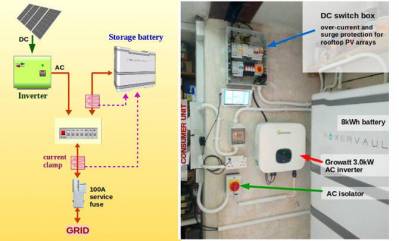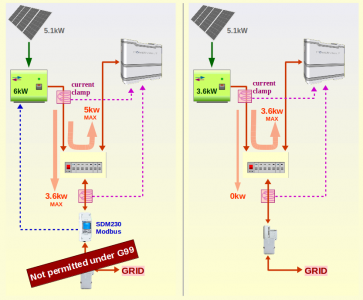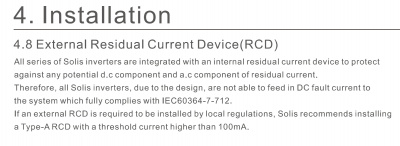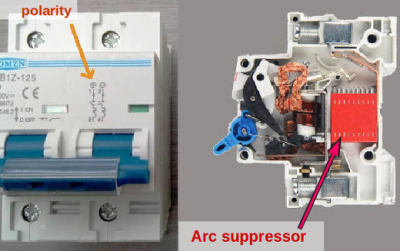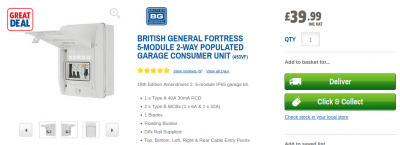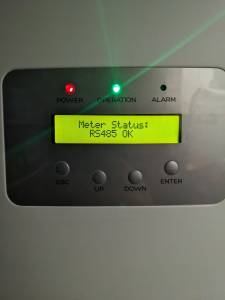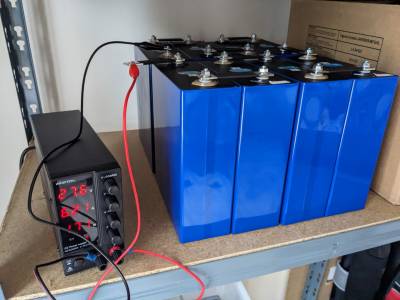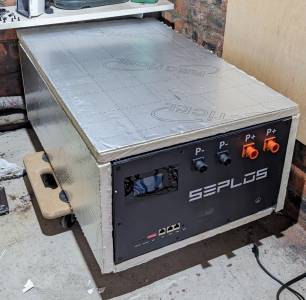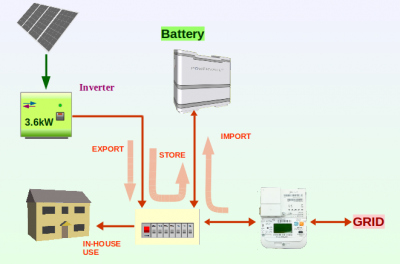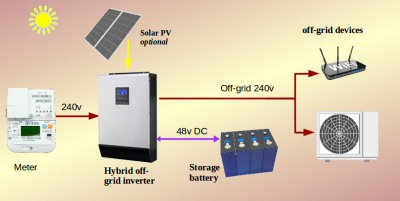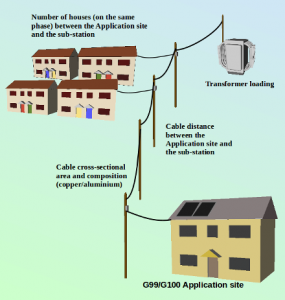Posted by: @bataltoJust put it house side - not grid side, and set not to export. Problem solved
Sorry - I disagree.
It may operate as you describe, but it doesn't comply with the regulations.
User-configuration processes to restrict the output to "in-home only" are not permitted by the ENA and its DNO members.
There has to be a pre-tested link between the solar-inverter and any mains-connected storage battery.
Invariably that means that they end up being from the same manufacturer.
Ie I believe that a Solar-Edge inverter with a Solar-edge battery is an approved combination.
For the purpose of an OVO-led trial, I had a PowerVault battery (8KWh) and a standard string-inverter made by Growatt (MIN 3600TLE).
That combination is not on the pre-approved list held by the ENA, and therefore required separate assessment by my DNO, which was called Western Power Distribution at the time (now NGED).
It was WPD who specified the max permitted output of the (Growatt) string inverter.
I had wanted to use a larger 6Kw inverter and Growatt's recommended method of restricting grid-export to 3,6kW using feedback from an Eastron meter.
That application was rejected.
As this topic is for Beginners, I would like to make these issues as clear as possible.
If you have two devices which have the capability of grid-export, then you must make an application under the G99-Fast-track process.
The process is simple, and the 'form' is available on the website of your DNO.
By April 2023 (four months time), NGED are intending to make this process so streamlined that most applicants will get a near-instant online response to a G99 application.
Save energy... recycle electrons!
I'm looking for a bit of input on the suitability of my next purchases.
1. @ChickenBig 's post ( https://renewableheatinghub.co.uk/forums/postid/11589 ) suggesting NH00 fuses for a DC fused disconnect led me to the following product: https://www.solartradesales.co.uk/keto-battery-disconnector-with-80a-fuses which I'm able to source for £47 delivered incl. fuses (£16 less than the Bimble Solar solution). The fuses are 80A rather than 125A but given my Solis inverter has a maximum charge/discharge current of 60A I believe that'll be sufficient. A quick search of the UK solar/battery Facebook groups shows many comparable installations using the linked product. Obviously these are not the T-type fuses favoured by @Transparent but I'm aiming for good enough rather than ideal...
2. My existing 2-way garage consumer unit has been disconnected and removed. The electrician suggested I replace it with the following product: https://www.screwfix.com/p/british-general-fortress-5-module-2-way-populated-garage-consumer-unit/453vf
His suggestion being based on the Type A RCD with MCBs. Similar to the DC fused disconnect, it seems that many people use this style of mini consumer unit to hook up their inverter despite some chatter that Type B RCDs are 'even better'. HOWEVER, I've since read the following in the Solis manual:
The Screwfix product has a 40mA RCD, and 100mA RCDs are neither common nor cheap. Could the RCD element be safely done away with as per the leanings of the Solis manual or would another solution be more suitable?
NH fuses. Ignore price for the moment @korwraith and let's concentrate on what the fuse is intended to do.
NH fuses are a German design/specification, so we should be unsurprised to see them favoured within a mechanical disconnector manufactured by Jean Müller.
They are made in several physical sizes, as denoted by the NH00 spec.
They are made in a range of 'classes', of which gS is the one required for handling battery connections.
I'm puzzled as the benefit of have two such fuses in the unit. Before opting for the Keto product, I suggest you research that.
I also don't understand the rational of having the protection fuse(s) within the mechanical disconnector handle.
When it is operated, a DC arc will form between the fixed contact and the NH fuse blade which is being moved away.
It is usually the case that a battery disconnector incorporates an arc-quenching ladder. These are found within properly-specified DC MCBs (trips).
The DC arc is pulled into the plates of the ladder by neodymium magnets adjacent to the contact points.
For that reason almost all DC breakers are marked with the required polarity.
There is no such arc-quenching incorporated into the Keto disconnector. The resulting arc will cause pitting on the surface of the fuse blade and the sprung contact.
When the circuit is reconnected, the rims around those pits will prevent a sheer-face contact between the fuse and its contact.
'Good practice' has tended towards having a static (bolted) fuse link for provide protection against a short-circuit at tens of thousands of Amps,
and a smaller trip (mcb) which serves as a manual method of disconnection, and provides protection for low-current overloads (125A and below).
The Keto unit is heading in a different direction, for reasons that are difficult to fathom.
2: Consumer Unit. Pre-loaded consumer units are cheaper that building your own from separate parts, but only if they come with the components you needed anyway.
Screwfix persist in advertising electrical components that are incorrectly described. I have written to them about this.... and received no response.
a: the RCD you refer to is a 30mA unit; 40mA units are not made.
That 30mA is to provide protection against death if a person should touch part of the live circuit.
The alternative 100mA RCD (and RCCD) units provide protection in case of fire only.
The IET Regulations require you to have the 30mA variety within the home.
b: Screwfix incorrectly refers to a Type B MCB. There is no such thing.
What they should have written is "an MCB with a B-curve", which is quite different.
The tripping curve of an MCB specifies the speed at which the contacts will open in relation to the level of over-load being detected.
This lack of attention to the required level of detail for safety protection devices means that I won't buy electrical items from Screwfix.
If an item proved to be 'faulty' then I'm not confident that the company would even understand the complaint or its severity. 😖
Use a proper electrical distributor such as TLC Direct or CEF.
Finally, how accessible is the integral RCD on the Solis inverter?
If it's not immediately obvious and can be tripped/tested manually, then I don't think it fulfils the obligations of the Wiring Regulations.
Save energy... recycle electrons!
1. NH Fuses. Strange that the Keto disconnector goes against current best practice trends, presumably this is down to commercial reasons rather than intentionally suboptimal design. I've decided to go ahead with the Keto disconnector despite this; whilst it may not be the most robust design I expect it'll be suitable for my light domestic use case.
With regards to gG/gS fuses, it seems that only gG NH fuses are widely available and it is this type that are universally bundled with the unit across all suppliers. The DIY Solar forum suggests these disconnectors should be seen primarily as cable protection devices and their spec should satisfy that requirement...
2. Consumer Unit. I spoke with the electrician regarding the Solis inverter's 100mA RCD recommendation and he's now suggested going in a completely different direction. Rather than putting it on a 30mA RCD and hoping for the best, he instead recommends running a dedicated SWA cable from the inverter to the main consumer unit area and he'll then connect it either after the consumer unit's mains switch or in an enclosed Henley Block prior to the consumer unit. He says the SWA cable negates the need for RCD protection and so entirely side-steps the issue. I need to run the CT cable from the inverter to the main supply in any case so I suppose it's not a great deal more work...in theory 😆.
That being said, had I known about this 100mA RCD stipulation a couple of months ago, I would have possibly forked out the extra cash for the Sofar ME 3000SP inverter as its manual specifies 30mA RCD to be acceptable!
You are correct to point out that the integral Solis RCD does not satisfy BS wiring regulations.
Mini update:
Inverter operational 👍 (or powered up and communicating correctly with the smart meter in any case 😆 )
Top balancing initiated 👍
I've been investigating battery heating options as the battery will be in my unheated garage (albeit integral to the house). The simplest solution seems to be a combination of a heat pad with a thermostat controlled wall plug; however, how often will the battery pack drop below e.g. 5'C? Unsure! It may well be that some insulation around the battery casing and the heat from charging/discharging is sufficient, experimentation required...
Posted by: @korwraithpowered up and communicating correctly with the smart meter in any case
Please clarify this comment @korwraith when you write "Smart Meter" are you referring to the display shown in the photo, or the Smart Meter which connects between your 100A Service Fuse and the consumer unit?
You'll probably find the best advice about heating pads and battery insulation on the DIY Solar Forum.
The moderator, Will Prowse, provides support for enthusiasts building battery-storage into huge American camper-vans.
They will often be in locations at sub-zero temperatures, so the RV owners have a number of strategies to deal with the issue.
I'm about to trial a BMS unit which has an output port specifically for running heat-mat.
That means it can ensure the mat gets switched on and the minimum temperature reached, before the charging cycle is allowed to start.
Most LiFePO4 cell manufacturers are happy to allow discharge below 0degC, however.
Check the spec for your particular cells.
Save energy... recycle electrons!
@transparent that would be the Solis provided energy meter with the CT clamp attached to it monitoring house power draw, not the smart meter that reports back to my energy supplier 😁. The Solis manual refers to the Acrel ACR10R as a smart meter which is evidently a bit confusing.
Thanks for all the great info.
To clarify. A certified inverter with a diy battery could get rejected by the dno?
I too was considering the Seplos Mason box option with an undecided hybrid inverter. Would providers like Octopus require a certified battery as well or are they only only concerned that the inverter and installation are certified?
Cheers.
That's a good question @onevolt
... and posted in the best place for an answer!
Point 1 is to agree what we mean by a "certified inverter".
If the inverter has the capability to feed 240v AC back to the distribution grid (ie it can 'export') then it must be certified to G98 and it requires permission from your DNO for an electrician to connect it.
This type of inverter is called 'grid tied' because it requires the 50Hz grid frequency to operate.
But... if the inverter creates 240v AC using its own internal 50Hz oscillator, then it can't be certified G98, nor can it ever export to the grid.
We call this an 'off grid inverter' because its 240v output can only be used to supply devices independently of the grid.
Off-grid hybrid inverters are a superset of those, because they can also charge your battery from a PV solar array.
Off-grid hybrid inverters are the likes of Growatt SPF5000ES, Phocos PSW-H-5Kw or the Voltacon Conversol range.
The Sunsynk hybrid inverters are a bit of a mix between the two camps.
They are both grid-tied, G98 certified and have a certified export-limitation system,
but they also have an off-grid output port which can run 240v AC devices from a battery when the grid is down.
Point 2. There are about 10 checks which the DNO makes when they approve a grid-tied device with export capability.
These include
- is there more than one device to be installed which can export? (G99 required)
- is the level of export to be greater than 3.68kW (16A per phase)
- the cable length between the site and the sub-station transformer
- the cable characteristics; its cross-sectional area and composition
- the number of houses between the site and the transformer
- the transformer rating and its free capacity
For example, you may tick all the boxes regarding the right equipment to install, but they might ask you to wait 3-months whilst they lay a thicker cable.
That's rare... but not unreasonable!
Point 3. Your Energy Supplier, Octopus, have no input to this.
They provide no certification of whatever inverters and/or storage batteries you install.
Save energy... recycle electrons!
Thanks for that explanation.
I didn't want to splash out on and build a battery based on the Seplos box only to be told I wouldn't be allowed to connect it to the grid.
So as long as the grid tied inverter is G98 or G99 certified then it shouldn't matter what the battery is? (assuming all the other points you mention re DNO are met and agreed upon)
- 26 Forums
- 2,396 Topics
- 54.3 K Posts
- 212 Online
- 6,077 Members
Join Us!
Worth Watching
Latest Posts
-
RE: Help me keep the faith with my air source heat pump installation
@simonf I’ll ask the installers to get them out. What k...
By AdamK , 6 hours ago
-
RE: Recommended home battery inverters + regulatory matters - help requested
Thanks for all the help/comments. I completely agree w...
By JamesPa , 9 hours ago
-
RE: ASHP Energy Consumption: Aira 12kW heat pump
I doubt that matters, ToU tariffs are for the benefit o...
By JamesPa , 14 hours ago
-

RE: Free Ecoheat Heat Pump Install
@deltona Yes older houses are problematic like that, bu...
By bontwoody , 17 hours ago
-
RE: Radiator sizing sanity check
As I mentioned early on the cost of supplying and fitti...
By JamesPa , 19 hours ago
-
RE: Advice for a novice on Mitsubishi Ecodan 6kW
I hadn't spotted that there were two pumps in the UFH (...
By JamesPa , 21 hours ago
-
RE: Setback savings - fact or fiction?
Never assume it makes an ass of u and me! You need the...
By JamesPa , 21 hours ago
-
RE: New Mitsubishi Ecodan 11.2kW installation - L9 errors and maybe more
Before I answer your specific questions just one more t...
By JamesPa , 21 hours ago
-
RE: Electricity price predictions
Great point, one of the key ones in my chat with Octopu...
By Batpred , 1 day ago
-
RE: Running from backup generaor in powercut?
Definitely and professionals sometimes miss it. I had...
By Batpred , 1 day ago
-

RE: New Fogstar 15.5kWh upright solution
Let me point out that there are many Chinese suppliers ...
By Transparent , 2 days ago
-

RE: Weather compensation- why you should use it
@majordennisbloodnok — The Two Ronnies Mastermind sketc...
By cathodeRay , 2 days ago
-
Just realised that this image of the cylinder cupboard ...
By Sheriff Fatman , 2 days ago
-

RE: Rodents! A word of warning for heat pump owners
Two thoughts: 1: Let's ask @david-s if Primary Pro in...
By Transparent , 2 days ago
-
RE: Solis S6-EH1P8K-L-PLUS – Why I Chose It and What I’ve Learned So Far
In the diagram below, I describe my understanding of th...
By Batpred , 2 days ago
-
I need to have a look out for it. I know IBM feeds some...
By Batpred , 2 days ago
-
-
RE: Daikin Atherma ASHP Cycling 6 Times an Hour?
Thanks for your reply. Yes that's a good idea to try a...
By John Marshall , 2 days ago
-

RE: Hot water heating in parallel with space heating
An external heat exchanger would need a pump which woul...
By bontwoody , 2 days ago
-
RE: Gen 6 Samsung ASHP losing 20C of DHW in 60 min directly after generation
@ecobaker Thanks for this. I've had it in both slots. ...
By andbeck , 2 days ago

